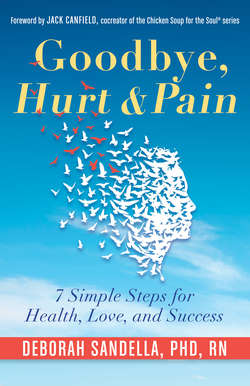Читать книгу Goodbye, Hurt & Pain - Deborah Sandella - Страница 20
На сайте Литреса книга снята с продажи.
Our Three Primal Feelings: Curiosity, Comfort, and Discomfort
ОглавлениеWe are born with three primal emotional states: curiosity, comfort, and discomfort. You can easily observe them in infants even though they cannot understand or verbalize their internal experience or thoughts. We come programmed with these neurological receptors.
Take curiosity, for example. Researcher Hildy Ross at the University of Waterloo, Ontario, found that a group of twelve-month-olds consistently preferred new toys to familiar ones and spent more time manipulating the complex array of toys rather than the simple ones.2 These findings suggest that we come into the world as explorers. That makes sense when we see how determined babies are to do whatever it takes to walk. If you have spent any time observing infants and toddlers, their curiosity is obvious—hence the large array of baby-proofing gadgets available to us.
Similarly, you do not have to be a researcher to know when an alert baby is comfortable. They have the curious glint in the eyes, the smile that tugs at your heart, and the sounds of squealing, gurgling, and laughing that create sympathetic delight in your body. You can sense an infant's spontaneous happiness without words. In fact, the joyful sight and sounds of a happy baby are contagious. Pay attention when you hear a baby cooing or a child laughing, and notice how your body responds. I remember once sitting on an airplane when a toddler's uncontainable giggles became audible in the silence immediately after landing. All of us began to make knowing eye contact and smiling at one another. As the spontaneous sounds continued to fill the cabin, our adult smiles finally burst into audible laughter. We just couldn't help ourselves. We all walked off the plane feeling great!
Although infants cannot tell us about their discomfort in words like older children, they give clues through their bodies. Pain is communicated through babies' bodies in changes to heart rate, breathing rate, and blood pressure. Infants act differently when they are in pain than when they are comfortable. Although each infant responds individually and may be inconsistent, there are certain behaviors like fussing, crying, furrowed brow, squeezed-shut eyes, and a quivering chin that reflect discomfort.
Discomfort is a visceral or physiological experience even when the source is emotional. Neuroanatomist A. D. Craig suggests the definition of human emotion to be both a subjective feeling and a body experience. He points out that, given this insight, emotions are not simply occasional events, but ongoing and continuous, even when they go unnoticed as unconscious human emotional acts.3 In other words, our feelings are constantly changing and creating different body experiences even when we are oblivious to them.
Although you may not remember your very early experiences, you too were born with the three spontaneous states of curiosity, comfort, and discomfort. Through the years you have evolved more complex feelings, but these primal emotions still strongly motivate behavior. As a growing baby, then child, you organically sought intuitive ways to maintain comfort. It all happened through your body, not your head, because your intellectual mind was immature.
The techniques you learn in this book will show you how to unravel primal discomfort dammed in your body. As it quickly and naturally evaporates, you can remember your inherent curiosity and childlike joy, regardless of age.
